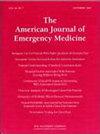Trends in stimulant-related emergency department visits among adults in California, 2017–2021
IF 2.7
3区 医学
Q1 EMERGENCY MEDICINE
引用次数: 0
Abstract
Background
Stimulants are becoming increasingly prevalent among overdoses, yet little is understood about how stimulant use impacts emergency department (ED) utilization.
Methods
Using data from California's Department of Healthcare Access and Information, we conducted a five-year trend analysis of stimulant-related ED visits from acute care hospitals in California from 2017 to 2021. For each year, we determined the stimulant-related ED visit rate per 100,000 ED visits for adults aged ≥18 utilizing ICD-10 diagnosis codes. We estimated the percent changes in overall stimulant-related visit rates during the study period and by subgroup, including by demographic characteristics, Charlson comorbidity index score (CCIS), and cardiovascular (CV) diagnoses. We used chi-squared analyses to examine changes in trends over time.
Results
The rate of stimulant-related ED visits increased from 2064.4 per 100,000 ED visits in 2017 to 2586.1 per 100,000 ED visits in 2021, a 25.3 % increase (P < 0.001). By race/ethnicity, people identified as Native American/Alaska Natives had the highest ED visit rate in 2021 (4713.5 per 100,000 ED visits) and the largest increase of 60.8 % (P < 0.001). The proportion of stimulant-related ED visits with CV disease diagnoses increased from 13.8 % in 2017 to 18.0 % in 2021, a relative increase of 30.8 % (P < 0.001).
Conclusions
Stimulant-related ED visits are increasing among adults in California, especially among non-white populations and those with higher comorbidity. This sharp rise highlights the critical need for targeted interventions and harm reduction strategies that consider the unique effects of stimulant use on ED rates and CV outcomes.
2017-2021年加州成人兴奋剂相关急诊就诊趋势
兴奋剂在过量用药中越来越普遍,但很少有人了解兴奋剂的使用如何影响急诊科(ED)的使用。方法利用加州医疗保健获取和信息部的数据,我们对2017年至2021年加州急症医院与兴奋剂相关的急诊科就诊进行了五年趋势分析。每年,我们使用ICD-10诊断代码确定≥18岁成人每10万次ED就诊中与兴奋剂相关的ED就诊率。我们估计了研究期间总体兴奋剂相关就诊率的百分比变化,并按亚组,包括人口统计学特征、查尔森合并症指数评分(CCIS)和心血管(CV)诊断。我们使用卡方分析来检查趋势随时间的变化。结果兴奋剂相关ED就诊率从2017年的2064.4次/ 10万次增加到2021年的2586.1次/ 10万次,增长25.3% (P <;0.001)。按种族/民族划分,美国原住民/阿拉斯加原住民在2021年的ED访问率最高(每10万次ED访问中有4713.5次),增幅最大,为60.8% (P <;0.001)。兴奋剂相关ED就诊与CV疾病诊断的比例从2017年的13.8%增加到2021年的18.0%,相对增长30.8% (P <;0.001)。结论加利福尼亚州成年人中与兴奋剂相关的ED就诊正在增加,特别是在非白人人群和那些有较高合并症的人群中。这一急剧上升突出表明,迫切需要有针对性的干预措施和减少危害的战略,考虑兴奋剂使用对ED率和心血管结果的独特影响。
本文章由计算机程序翻译,如有差异,请以英文原文为准。
求助全文
约1分钟内获得全文
求助全文
来源期刊
CiteScore
6.00
自引率
5.60%
发文量
730
审稿时长
42 days
期刊介绍:
A distinctive blend of practicality and scholarliness makes the American Journal of Emergency Medicine a key source for information on emergency medical care. Covering all activities concerned with emergency medicine, it is the journal to turn to for information to help increase the ability to understand, recognize and treat emergency conditions. Issues contain clinical articles, case reports, review articles, editorials, international notes, book reviews and more.

 求助内容:
求助内容: 应助结果提醒方式:
应助结果提醒方式:


